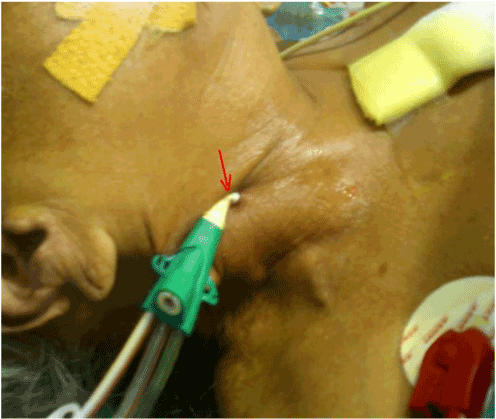Case report
55 years female presented with shortness of breath on mild exertion since 1 month. On evaluation, she was found to have severe aortic stenosis with left ventricular dysfunction. Patient was scheduled for aortic valve replacement surgery. After smooth anaesthesia induction, advanced venous access 9 Fr. with triple lumen ports was inserted in right internal jugular vein. After aortic valve replacement, patient was weaned from cardiopulmonary bypass with support of vasopressor drugs - adrenaline 0.1 mcg/kg/min and noradrenaline 0.08 mcg/kg/min. The drugs were administered through one of the ports of central venous catheter (CVC). Patient was shifted to recovery room with stable hemodynamics with support of the same inotropic infusions. However patient started deteriorating 2 hours later. Mean arterial pressure dropped to 50 mm Hg even after vasopressor infusions were escalated. It was decided to insert swan ganz catheter to guide therapy based on hemodynamic parameters. As the pulmonary artery catheter was inserted through the catheter port of advanced venous access, hemodynamics started improving. MAP became 65 mm Hg. Was the pulmonary artery catheter breakthrough in the management or reason was something else?
Advanced Venous Access (AVA) has integrated introducer port for swan ganz catheter insertion and multi-lumen central venous access. It has flexible lumen walls that quickly adapt to fluid delivery needs. However such soft and flexible catheter is more prone to kinking if it's not secured well. As the patient was shifted to recovery room after the surgery, sterile dressing over the central venous insertion site is changed as a routine practice. Probably the catheter might have got bent during the dressing, which went unseen. Little bent or kink in the catheter is capable enough to compress catheter lumens and create obstruction in inotropic infusions. (Figure 1). This was noticed when catheter was exposed for pulmonary artery (PA) catheter insertion. As the PA catheter was being inserted into the AVA port, kink part of the catheter got straightened up and reduced the effect of bent. Proper delivery of the inotropes and vasoconstrictors make the hemodynamics better within few minutes of PA catheter insertion.

Figure 1. Kinking of advanced venous access (marked by arrow)
Large bore central venous catheters also facilitate extremely rapid infusion of resuscitation fluid [1] In contrast to conventional CVC; AVA is soft and flexible, and susceptible to kinking easily. Many introducer sheaths are relatively stiff and can cause perforation of the superior vena cava and innominate veins [2]. Firm fixation of the catheter is advocated to avoid rhythm disturbances and perforation of the heart due to catheter displacement [3]. It needs to be fixed straight and without any bent to ensure proper flow of infusions.
References
- Dailey RH (1985) “Code Red” protocol for resuscitation of the exsanguinated patient. J Emerg Med 2: 373-378. [Crossref]
- Taylor RW, Palagiri AV (2007) Central Venous Catheterization: Concise Definitive Review. Crit Care Med. 35: 1390-1396.
- Curelaru I, Linder LE, Gustavsson B (1980) Displacement of catheters inserted through internal jugular veins with neck flexion and extension. A preliminary study. Intensive Care Med. 6: 179-183. [Crossref]
2021 Copyright OAT. All rights reserv
Editorial Information
Editor-in-Chief
Article Type
Case report
Publication history
Received date: May 07, 2016
Accepted date: May 20, 2016
Published date: May 23, 2016
Copyright
©2016 Raut MS. This is an open-access article distributed under the terms of the Creative Commons Attribution License, which permits unrestricted use, distribution, and reproduction in any medium, provided the original author and source are credited.
Citation
Raut MS (2016) Undiagnosed kinking of advanced venous access. Glob Anesth Perioper Med 2: doi: 10.15761/GAPM.1000147
Corresponding author
Monish S. Raut
Department of Cardiac Anesthesiology, Sir Ganga Ram Hospital, New Delhi, India,
E-mail : monishraut@sify.com

